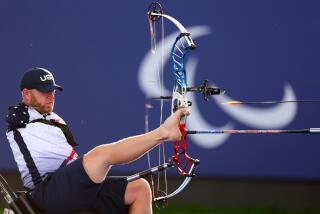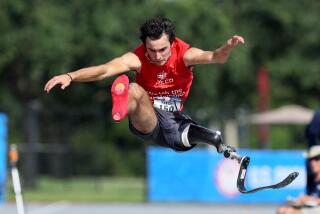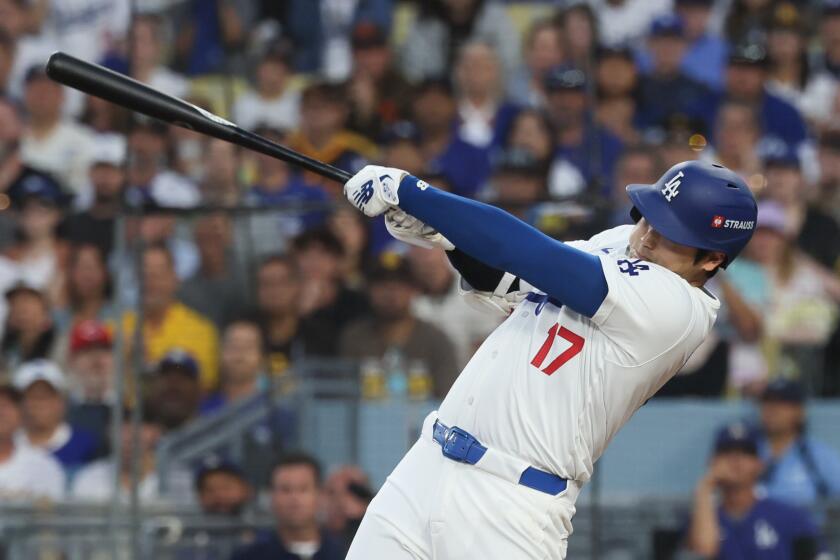The King of Sweden coined the phrase for Jim Thorpe in 1912, and decathletes have sought it ever since. Now Dan O’Brien tries to overcome his heartbreak of four years ago to be known as... : World’s Greatest Athlete : O’Brien Halfway From Ending 20-Year Drought
- Share via
ATLANTA — Dan O’Brien is the leader in the clubhouse, but that’s where the comparison ends. After all, nobody ever pretended that the leader after Thursday’s round at the Lovely Willow Country Club was trying to become the world’s greatest athlete.
This is the decathlon, and after Wednesday’s first half at Olympic Stadium here, O’Brien is nicely atop the leaderboard.
This is also an American tradition, and all the apple pie is one day away from the eating for this resident of Moscow.
Moscow, Idaho, that is.
The tradition is Jim Thorpe, the Native American, in the Stockholm Olympics, winning it all and starting it all, followed by names now mostly forgotten: Harold Osborn in 1924, James Bausch in ‘32, Glenn Morris in ’36.
And then, after the war, there was the high school kid from Tulare, Calif., finishing up a couple of high school meets before heading across the pond to win the 1948 London Games, a feat Bob Mathias repeated in ’52 in Helsinki.
Soon, the tradition became nearly a rubber stamp. Milt Campbell in ’56 at Melbourne, Rafer Johnson in ’60 at Rome, Bill Toomey in ’68 in Mexico City, Bruce Jenner carrying the tradition and the flag around the track after winning in ’76 in Montreal.
Then came the drought, caused in part by an American boycott of the Olympics in 1980 in Moscow.
Moscow, Russia, that is.
It was also caused, in part by a British marvel named Daley Thompson, who was as colorful as he was talented while winning in ’80 and ’84.
The last part of the drought has to do with O’Brien. Since the early ‘90s, he has been the best in the world. He has won world championships in 1991, ’93 and ’95. In 1991, he became the king of the first day, turning in an amazing 4,747 points for five events at the U.S. championships in New York City, en route to a winning 8,842 total. And in 1992, in Talence, France, he started with a 4,720 first day and established the current world record with 8,891.
The problem was, that was after the Barcelona Olympics. O’Brien was a no-show for that, having committed the unpardonable sin of failing to make the Olympic team and leaving an entire shoe company with gum on its soles.
In the U.S. trials for Barcelona, O’Brien failed to make any height in the pole vault. That meant no points and no deal for the big Reebok promotion, which had touted the “Dan and Dave” show as the greatest athletic head-to-head since Ali-Frazier.
It turned out to be a $25-million billboard with a typo. There was no Dan in Barcelona, and Dave Johnson competed on a stress fracture in his foot. While Johnson, miraculously, got the bronze, Reebok got the shaft.
WEDNESDAY, THE FIRST DAY
No gum-up this time.
O’Brien built a 144-point lead, winning the fastest heat of the 400 meters in 46.83 seconds and adding 967 points to a total of 4,592 that, while nowhere near his world-record pace, appeared to position him for a gold medal.
None other than Rafer Johnson, a spectator here Wednesday, saw mostly pluses in O’Brien’s first day.
“After the long jump, I wasn’t sure how this would go,” Johnson said. “But then, it looked like he was getting stronger in the high jump. I felt good after seeing that.”
Johnson was asked about O’Brien’s typically sensational first day, and about what some of his strong first days had been as a competitor.
“I can’t even remember,” he said, laughing. “I was so far below the kinds of points he puts up, I wouldn’t have even been close.”
O’Brien started with a 10.50 in the 100 meters, second best of the day behind teammate Chris Huffins’ 10.47 and worth 975 points. Next was the long jump, where he went 24 feet 10 inches and added 952 points, followed by the shotput, where his 51-4 1/4 was worth 830 points. He got off the 51-4 1/4 on his second put and, for all intents and purposes, he was in the lead for good. (He slipped to second a couple of times temporarily, when he passed at a high jump height in the fourth event while another competitor was making it.)
He cleared 6-9 1/2 in the high jump, missing three times at 6-10 3/4 and settling for 868 points. At this point, Huffins, the 26-year-old former NCAA champion at Cal, moved into second, only 46 points behind O’Brien.
But then came the 400 meters. O’Brien had the previous best time of anybody in the field with his 46.53, and with the full vocal support of an enthusiastic crowd of 82,839--its attention no longer on other events because all the finals on the program were finished--he ran close to that personal best. The 967 points he added with his 46.83 seemed to give him one foot on the victory stand.
Frank Busemann of Germany was second with 4,468, Erki Nool of Estonia third with 4,457 and Huffins down to fourth with 4,448.
TODAY
If O’Brien keeps rolling to the gold medal, he will do more than merely re-establish the great American decathlon tradition.
He will become only the second American to win the decathlon gold at an American Olympics, following Bausch at the first Los Angeles Olympics in 1932. He will also become the 11th American decathlon gold medalist.
His closest rival, Busemann, seems to have an Achilles’ heel in the discus. His best throw, 151 feet, is 22 feet 4 inches and 142 points behind O’Brien’s 173-4 best. That alone could sink Busemann’s bid.
Busemann is better than O’Brien in the 1,500, the last event of the 10-event grind, but not markedly. Plus just about everybody is better in the 1,500 than O’Brien, who has a history of not needing great marks by the time that comes around and mailing in a jog in the park.
Nool, the current third-place competitor, is a full second slower than O’Brien in the 110-meter hurdles, today’s first event; some 39 feet shorter in the discus; a tad better in the pole vault; about 50 points better in the javelin and about the same in the 1,500.
Huffins, who led O’Brien after the first day of the U.S. trials, appears by his comparative best marks to have a scramble on his hands to grab a medal.
Perhaps the key issue today will be event No. 8, the pole vault. When O’Brien failed to clear a height in the ’92 trials, it left him devastated, confused and in need of a psychologist. It became a case of so much work, so much promise and so little reward.
Then he cleared 14 feet 9 inches in his first attempt in the trials in Atlanta in June, and he treated it like an exorcism. Toomey, there for moral support, greeted him as he came off the track with the words: “Welcome to Mount Olympus.”
Barring a return of the demons that kept him from getting over the pole vault bar and on his way to Barcelona in 1992, he will be heading toward a special height today. It won’t be Mount Olympus, merely the top step of a victory stand.
How It’s Scored
The decathlon is a two-day, 10-event competition in which points are awarded based on a set of tables approved by the International Amateur Athletic Federation. The better the performance in each event, the greater the number of points allocated.
The points vary at different levels. For example, in the 100 meters, the difference between 10.4 seconds and 10.5 seconds is 24 points, but between 11.4 and 11.5 is 21 points.
Day 1
The top finishers in each event, with mark and points earned
100 Meters:
Dan O’Brien, U.S
10.50: 975 points
Frank Busemann, Germany
10.60: 952
Erki Nool, Estonia
10.65: 940
Chris Huffins, U.S
10.47: 982
Eduard Hamalainen, Belarus
10.85: 894
*
Long Jump:
Dan O’Brien, U.S
24-10: 952
Frank Busemann, Germany
26-5 3/4: 1079
Erki Nool, Estonia
25-10 1/4: 1030
Chris Huffins, U.S
24-7: 932
Eduard Hamalainen, Belarus
24-6 1/2: 930
*
Shotput:
Dan O’Brien, U.S
51-4 1/2: 830
Frank Busemann, Germany
44-7 1/2: 704
Erki Nool, Estonia
45-11 3/4: 729
Chris Huffins, U.S
51-1: 825
Eduard Hamalainen, Belarus
53-6 1/2: 871
*
High Jump:
Dan O’Brien, U.S
6-9 1/2: 868
Frank Busemann, Germany
6-8 1/4: 840
Erki Nool, Estonia
6-7: 813
Chris Huffins, U.S
6-8 1/4: 840
Eduard Hamalainen, Belarus
6-6: 785
*
400 Meters:
Dan O’Brien, U.S
46.82 (967): 4,592
Frank Busemann, Germany
48.34 (893): 4,468
Erki Nool, Estonia
47.26 (945): 4,457
Chris Huffins, U.S
48.83 (869): 4,448
Eduard Hamalainen, Belarus
46.91 (963): 4,443
Day 2
A look ahead to today’s final five envents
110-Meter Hurdles:
An event in which Dan O’Brien scores very well and one in which he won at the U.S. trials in 14.04 seconds. A similar mark today would net him about 969 points.
*
Discus:
U.S. teammate Steve Fritz outdueled him at the trials, but O’Brien held his own at 162 feet. A similar mark today would net him about 867 points.
*
Pole Vault:
A strong event for O’Brien, but also the one that cost him a trip to the 1992 Games, when he no-heighted. A repeat of his 17-0 3/4 mark at the trials would net him about 972 points.
*
Javelin:
A personal-best throw of 214 feet at the trials makes this one of O’Brien’s best and favorite events. A similar mark today would net him about 817 points.
*
1,500 Meters:
O’Brien’s worst comes last in event in which he struggled to finish 14th out of 16 runners at trials. If he doesn’t have the competition sewn up by this event, he’s in big trouble.
More to Read
Go beyond the scoreboard
Get the latest on L.A.'s teams in the daily Sports Report newsletter.
You may occasionally receive promotional content from the Los Angeles Times.







